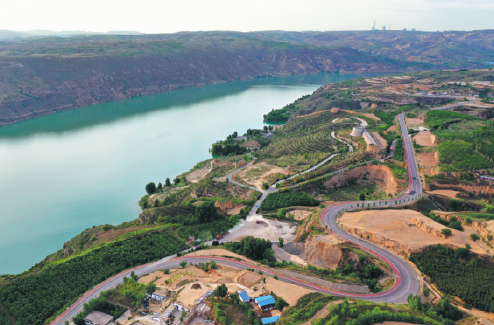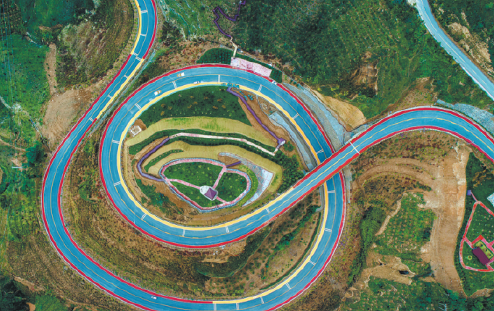Highway to heaven
Updated: 2024-07-19
Enhanced road network opens up access to almost 1,000 tourist sites across Shanxi province
Shanxi's landmark attractions – the Yellow River, the Taihang Mountains and the Great Wall – are now connected by the trunk roads of three major sightseeing highways, allowing tourists to better experience the province's spectacular natural wonders, long history and brilliant cultures.
Since 2018, North China's Shanxi has invested nearly 100 billion yuan ($13.75 billion) in the construction of sightseeing roads. With a planned total length of 13,000 kilometers, the three highway systems – which are called Yellow River No 1, Taihang No 1 and Great Wall No 1 – are designed to link nearly 1,000 tourism sites among the three attractions, according to a local official.
These three highways also connect to other transport systems – national and provincial truck highways, high-speed railroads and airports – in Shanxi. "The sightseeing highways give people fast access to and an in-depth touring experience of various destinations," the official said.
The official added that the project was designed to promote the integrated development of transportation, tourism and rural vitalization.
Local statistics show that the bulk of the three No 1 highways, with a total length of 10,900 km, has been opened to traffic. Officials said the entire project will be completed by the end of this year.
The project will also feature infrastructure to offer services for self-driving tourists. Facilities like filling stations, charging stations, recreation vehicle parks and scenic viewpoints have been built along the roads and these will continue to increase and improve in the future, said the officials.
Shanxi's three landmark attractions offer a unique appeal to tourists but the road journeys along the three routes had been challenging because of the distance they cover. The new highways aim to alleviate that.
Shanxi is one of the best places to see Chinese architectural wonders of the Great Wall. As the country's most iconic ancient defensive structure, the Great Wall was built in a period spanning some two millennia from the Warring States Period (475-221 BC) to the Ming Dynasty (1368-1644).
With a total length of more than 3,500 km across Shanxi, the Great Wall runs through nine cities and about 40 counties in the province. More than 1,500 km of walls and other relics remain relatively intact.
The 5,464-km-long Yellow River – which has a course of 965 km serving as the border between Shanxi, Shaanxi and Henan provinces – has the same importance as the Great Wall in Shanxi's tourism industry.
The Yellow River enters Shanxi at the village of Laoniuwan, which means "Old Ox Bay", in Pianguan county. From the village, the river has left one of its most beautiful features – the Shanxi-Shaanxi Grand Gorges. The gorges were formed by the Yellow River cutting through the Loess Plateau over millions of years.
Also holding an important position in Shanxi's tourism map are the Taihang Mountains. Extending more than 400 km from north to south, they are among the largest ranges in North China.
With breathtaking peaks, steep cliffs, unique rocks, lush forests and clean waters, Taihang is regarded by many sightseers as a place to be visited many times.
As the Yellow River, Great Wall and Taihang Mountains are located in the west, north and east of Shanxi respectively, it might be difficult for tourists to visit all three attractions in a short period of time. However, with the construction of three major sightseeing roads, travel in Shanxi has been made easier.
Yellow River No 1
The Yellow River No 1 Highway is designed to string together more than 200 scenic spots, including wetlands, waterfalls, ancient villages and ancient ferry ports, with the aim of boosting local tourism.
With a total length of 1,238 km, the trunk road of Yellow River No 1 begins in Pianguan's Laoniuwan and ends in Xihonghong village in Yuanqu county. It covers four major Shanxi cities of Xinzhou, Lyuliang, Linfen and Yuncheng.
As the starting point of this route, the village of Laoniuwan has been transformed into a popular tourist destination. Laoniuwan is a landmark in Shanxi, not only because it is the beginning of the grand gorges but because it is the intersection of the Yellow River and the Great Wall.
The village borders the Inner Mongolia autonomous region in the north and neighbors Shaanxi province in the west. Locals call it a place where "the cock's crow can be heard in three provinces".
At the convergence of the Yellow River and the Great Wall, the most spectacular part of the area is a big, 180-degree bend that forms a small peninsula opposite to the village.
Standing on the peninsula is a Great Wall watchtower called Baozita, which was built in the early Ming Dynasty. It is a vantage point of the Yellow River, which used to be a torrential waterway but became a lake after a reservoir was built in the 1990s.
It has also silently witnessed the incessant flow of the river and witnessed changes in the area for hundreds of years.
One of the changes it has seen in recent years is what the sightseeing roads brought to local life.
Several years ago, tourism in this historical village was not so prosperous compared to other famed destinations in Shanxi due to underdeveloped transport.
The situation has changed now with the construction of the Yellow River and Great Wall sightseeing roads.
The village provides visitors with the opportunity to explore the mysterious fortresses of the Great Wall and experience the beauty of the Yellow River. Visitors can also savor delicious farm-to-table cuisine and enjoy overnight accommodation in unique cave dwellings, with a chance to sleep on a kang – a cozy clay-and-brick stacked bed heated from within.
Almost every family in Laoniuwan now runs a homestay and tourism has become a cash cow for the villagers, according to an official of the village.
Local man Guo Jianhua, who operates a bed-and-breakfast business, said that he had more than 100 tourists staying and dining at his B&B establishment at the peak of his operation, generating a daily income of about 3,000 yuan.
On the Yellow River No 1, a constant flow of cars with non-local license plates is evident, accompanied by thriving businesses lining the highway. The local villages, once obscure and forgotten, have been revitalized and are now bustling with activity.
Taihang No 1
When mentioning a road that can provide self-driving tourists with a sightseeing experience of a long range of spectacular mountains, one may think of the Blue Ridge Parkway in the Appalachian Mountains in the United States, which inspired John Denver to write his famous song Take Me Home, Country Road.
Now Shanxi province has a similar road in its Taihang Mountains region. The Taihang No 1 Highway starts from Yaodu village in Qinshui county and ends in Pingxingguan village in Fanshi county in the north. With its trunk line and branches covering the five cities of Jincheng, Changzhi, Jinzhong, Yangquan and Xinzhou, the road system now has more than 4,100 km opened to traffic.
The Taihang Mountains are a famed tourist destination in China, featuring a perfect combination of natural and cultural wonders.
Like the sentiment of Denver when driving on the Blue Ridge Parkway, a yearning for singing is often inevitable for tourists on the Taihang roads. This is especially true on the Lingchuan section of Taihang No 1.
The road features the three colors of red, yellow and blue on its surface. But the most amazing part of it is that it can sing. When driving at a speed of 30 km per hour on the road, electronic devices along the road will sing a song that is familiar to many – In the Taihang Mountains.
The song is a tribute to the national heroes who fought invaders there during the War of Resistance Against Japanese Aggression (1931-45). And when the music resonates between the "iron walls of Taihang", it can easily strike a chord among tourists.
One of the most imposing sights in the Taihang region are the cliffs rising up from the valleys. The cliffs are often called the "iron walls of Taihang".
But for many Chinese people, the term is not only a description of the landscape, but homage to the heroes who protected the nation.
About 80 years ago, the Taihang Mountains were an important base for the Eighth Route Army led by the Communist Party of China, a vital force in the war of resistance.
When the Chinese nation and its people were at their most critical moment, the warriors of the army pledged to "build a new Great Wall with their very flesh and blood". Many of them sacrificed their lives to honor this pledge and rendered new significance to the "iron walls of Taihang".
Taihang is now home to a great number of Red tourism sites related to China's revolutionary history, like the Eighth Route Army Memorial Museum in Wuxiang county, and the site of the Hundred-Regiment Campaign in Yangquan city.
The county of Lingchuan, where the "music highway" is located, was one of the important bases for the army during the war and is also the birthplace of the song In the Taihang Mountains.
In addition to "the road of music", Lingchuan has a road reflecting the enterprising spirit of contemporary locals.
In the mountain-locked village of Xiyagou, residents who had lived in isolation aspired to be linked to the outside world for hundreds of years. This was realized late last century with the construction of a "cliff-hanging road".
The change took place in the early 1980s when local officials and residents agreed to build a road linking it to the rest of the county and Shanxi province.
Song Zhilong, 69, was the former chief of the village. He recalled how the road was built. "We had mobilized almost all the resources of the village. In addition to investment from the county government, many families contributed their savings to the project.
"The job to build a road on and through the cliffs was by no means easy. As the natural conditions didn't allow the use of explosives, we cut through the cliffs inch by inch.
"The total length of the road is only 7.5 km but it took us about 10 years to complete," Song said.
After its completion in 1991, the road was listed as one of China's top 60 new landmarks by the then National Administration of Tourism. It immediately turned the village into a popular attraction in Shanxi.
The road and Taihang No 1 are presenting the hidden charms of the mountains to tourists and bringing visible benefits to locals.
Great Wall No 1
The Great Wall No 1, starting from Laoniuwan in Pianguan county in northwestern Shanxi and ending in Pingxingguan in the eastern Shanxi county of Fanshi, is a road network of 3,573 km, including 1,171 km of trunk lines and 1,566 km of branch lines.
Shanxi is one of the nation's leading provinces in Great Wall-related tourism. The northern Shanxi city of Datong was one of the nine border garrison towns in the Ming Dynasty, when construction of the Great Wall reached its height for the purpose of defending against the remnants of the northern Mongol Yuan forces. To this date, the city holds the largest number of Great Wall relics in Shanxi.
Datong is strategically located at the natural boundary between the farming areas of Shanxi and the nomadic areas in the north. Many Great Wall sites from multiple dynasties are located within the city. The Datong Great Wall consists of both an inner and an outer layer, with a total length of 503 km, of which the Shoukou Fortress, Zhenbian Fortress, Desheng Fortress and Xinping Fortress are all well preserved and worth visiting.
Among the many Great Wall fortresses in Datong, the Desheng Fortress is the most well known among tourists.
Desheng was originally built in 1538 and was renovated and enhanced in 1574 and 1607 respectively. It features 18 watchtowers and four turrets on the four corners of the wall. While functioning as a stronghold during wars, the fortress was a hub for trade and cultural exchanges in times of peace.
Even in the modern era, the strategic importance of Shanxi's Great Wall has remained. Since 1937, as part of the War of Resistance Against Japanese Aggression and World War II, numerous battles took place along the walls.
In September 1937, for instance, the Eighth Route Army launched a battle against the Japanese invaders at the Great Wall pass of Pingxingguan and won a victory that helped to raise the morale of the entire Chinese military.
Both Desheng and Pingxingguan fortresses are accessible with the Great Wall No 1 Highway. The road system offers great convenience for tourists, allowing them to easily travel to any site of the Shanxi Great Wall sections.
Li Yao contributed to this story.


From left: A section of a rural road in Lingchuan county, which is a branch of the Taihang No 1 Highway. A road sign on a sightseeing highway in the Taihang Mountains. A spectacular bend of the Yellow River near Pianguan county's Laoniuwan village, where the river and the Great Wall meet. Provided to CHINA DAILY

A sightseeing road twists its way close to the Yellow River. Provided to CHINA DAILY

A section of the Great Wall in Shanyin county. Provided to CHINA DAILY

An overhead view of the Yellow River No 1 Highway in Linfen city. Provided to CHINA DAILY

From left: The Yellow River winds its way between Shanxi and Shaanxi provinces. A group of statues stand in front of the Pingxingguan Victory Memorial Museum in tribute to the Chinese warriors who fought invaders during the War of Resistance Against Japanese Aggression (1931-45). At the heart of the Taihang Mountains, the beautiful village of Hongni in Pingshun county has developed into an emerging rural tourism destinations thanks to its connection to the Taihang No 1 Highway. A section of the ancient Great Wall in Datong offers a sharp contrast with a modern wind farm close by. Provided to CHINA DAILY

